 Waste Isolation Pilot Plant federal and contractor employees took part in a recent Hispanic Heritage Month panel discussion. From left are Nancy Bradford with CNB Bank; Rocio Espinoza and Raymond Dominguez with New Mexico State University-Carlsbad; Ed Garza with the EM Carlsbad Field Office; and Yolanda Navarrete with Nuclear Waste Partnership.
CARLSBAD, N.M. – Nuclear Waste Partnership (NWP), EM’s primary contractor at the Waste Isolation Pilot Plant (WIPP), collaborated with New Mexico State University-Carlsbad to mark Hispanic Heritage Month by hosting a panel spotlighting key Latinx people who have advanced their careers and inspired early career professionals within their community.
Watch a video of the Hispanic Heritage Panel discussion, held at the university campus, here.
Hispanic Heritage Month, which ends Oct. 15, is celebrated annually to recognize the rich history and culture of the U.S. Latinx and Hispanic communities.
Guest speakers on the panel ranged in career and level of expertise, with each having an inspiring story and advice for people listening in person or virtually. They included Ed Garza, EM Carlsbad Field Office assistant manager for the Office of WIPP; Yolanda Navarrete, NWP manager of employee concerns; Rocio Espinoza and Raymond Dominguez, representatives with New Mexico State University-Carlsbad; and Nancy Bradford with CNB Bank.
The panelists discussed the key role Hispanic heritage played in their careers and the significance of an inclusive workforce.
“I probably had the privilege of not having to run into barriers because of my parents,” Garza said. “My father was very involved in the Lubbock (Texas) area with different things in the Latino community, so the barriers I probably would have run into, he and his friends knocked down.”
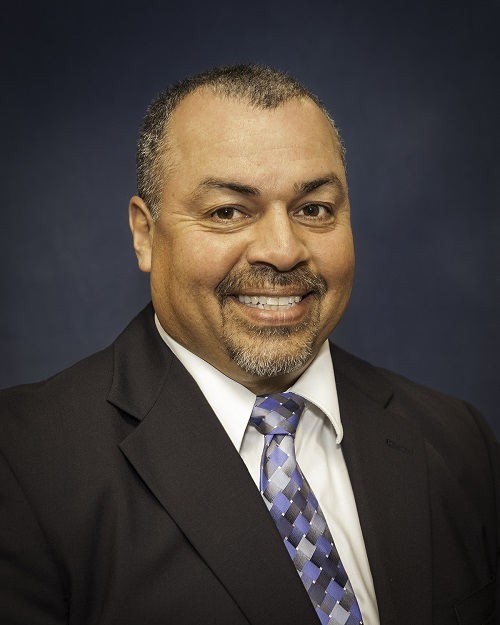 |
|
Ed Garza, EM Carlsbad Field Office assistant manager for the Office of WIPP, served on a Hispanic Heritage Month panel highlighting Latinx people who have advanced their careers and inspired early career professionals. |
Yolanda Navarrete, Nuclear Waste Partnership manager of employee concerns, discussed mentorship, education, and other topics as part of a panel marking Hispanic Heritage Month. |
|
 |
The panelists also talked about the importance of mentorship in career advancement.
“None of us are perfect. We can all learn something from everyone we work with,” Garza said. “I tell my staff that you can mentor in all directions, both up and down. Having a mentor to help you grow as a leader is very important, especially in young leaders.”
Navarrete also reflected on her past mentorships.
“I’ve had many mentors over the years, and I have completely appreciated and learned from each and every one of them.”
Garza’s last bit of advice to young Latinx individuals who are now joining the workforce was quite simple: Do your job.
“If you are given the opportunity to get into a career, if you want to stand out, don’t stand out in a bad way,” he said. “If you do your job, you will stand out in a good way. You will separate yourself, and you will be noticed. This is going to open up doors and opportunities, and when those opportunities come along, don’t be afraid.”
In her final remarks, Navarrete emphasized the importance of education, culture, and most importantly, staying true to yourself.
“I encourage you to be true to yourself, get your education, and follow your dreams and your goals,” she said. “And best wishes to you.”
-Contributor: Maelene Soto
 The Environmental Management Site-Specific Advisory Board is considered a single advisory board; however, eight local boards are organized under its umbrella charter, one at each major EM cleanup site.
Members of eight local advisory boards across the cleanup complex gathered virtually last week for the biannual Environmental Management Site-Specific Advisory Board (EM SSAB) National Chairs meeting, where they discussed EM’s COVID-19 response, cleanup progress and accomplishments, regulatory and policy priorities, technology development efforts, the status of EM’s budget, and board membership.
EM leadership from both headquarters and the field sites attended the two-day meeting to provide program updates and hear directly from local advisory board members regarding EM activities.
“It is imperative that we have open communication and transparency with members of the community who live and work near our sites where cleanup is taking place,” EM Principal Deputy Assistant Secretary Todd Shrader said.
Mark Gilbertson, EM’s Associate Principal Deputy Assistant Secretary for Regulatory and Policy Affairs, provided insight on the alignment between EM and the Administration’s goals. He highlighted ongoing efforts to reduce energy use and greenhouse gas impacts from EM facilities and activities. He also discussed some of EM’s climate action initiatives that will prepare the complex for the effects of extreme weather events.
The majority of the second day of the meeting focused on EM SSAB members developing cross-cutting recommendations for EM related to community outreach and communication. Members have been preparing for these discussions over the last year by conducting research to understand each EM site’s public communications and outreach. Committees made up of board members from each site were formed to analyze this research and draft recommendations. The final recommendations will be sent to EM headquarters after they are approved by each local board.
The next EM SSAB National Chairs meeting is planned for April 2022.
-Contributors: Kelly Snyder
 Charles Waggoner, center, former director of Mississippi State University’s (MSU) Institute for Clean Energy Technology, has been recognized with DOE’s Distinguished Career Service Award. MSU Vice President for Research and Economic Development Julie Jordan, left, and EM Associate Principal Deputy Assistant Secretary for Field Operations Nicole Nelson-Jean presented Waggoner with the award last week.
STARKVILLE, Miss. – DOE recognized a former Mississippi State University (MSU) research center director with a career award honoring his work to evaluate and improve high efficiency particulate air (HEPA) filters used to contain nuclear materials.
Charles Waggoner, director emeritus of MSU’s Institute for Clean Energy Technology (ICET), was presented with the DOE Distinguished Career Service Award by EM Associate Principal Deputy Assistant Secretary for Field Operations Nicole Nelson-Jean. Waggoner led the institute’s testing programs for 23 years before retiring earlier this year.
“Dr. Waggoner’s work led the industry and the accompanying codes down a path to withstand harsh conditions and accidents, to provide better protection for workers, the environment, and the public across the nuclear industry,” EM Acting Assistant Secretary William “Ike” White said in the award presentation. “The test program at MSU ICET is Dr. Waggoner’s crowning career achievement, and it will continue to be an asset to DOE and to the future of the nuclear industry.”
A three-time MSU graduate, Waggoner earned bachelor’s and master’s degrees in biochemistry before completing his Ph.D. in physical chemistry in 1985. He served as the university’s hazardous waste officer and an assistant professor in the Department of Chemistry for five years before leaving to lead the Division of Environmental Science and Technology at Chattanooga State Technical Community College.
Waggoner returned to MSU in 1997, where he soon began working on DOE-funded efforts related to HEPA filters used to remove radioactive material from the air.
The research and testing carried out by Waggoner and his colleagues has led to international recognition for MSU. At ICET, Waggoner developed capabilities for testing filters under worst-case scenario conditions. The data gathered from HEPA filter testing at ICET is used to guide filtration standards at past and present nuclear facilities.
“Dr. Waggoner is incredibly deserving of this career honor,” MSU Vice President for Research and Economic Development Julie Jordan said. “His leadership and knowledge have been invaluable to the Department of Energy while cultivating and leading an outstanding team of researchers at MSU. His work will leave a lasting legacy at MSU and in the nuclear industry. We all wish him a happy retirement and congratulations on a job well done.”
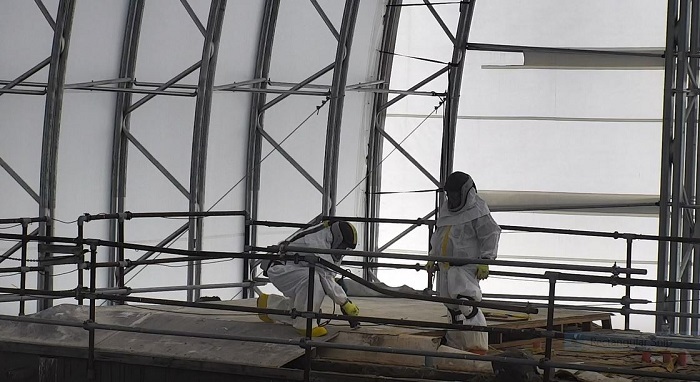 EM workers cut through the roof of the final hot cell at the former Radioisotope Development Laboratory at Oak Ridge National Laboratory for characterization work.
OAK RIDGE, Tenn. – Crews are getting ready to deactivate the final hot cell of the former Radioisotope Development Laboratory at Oak Ridge National Laboratory (ORNL) in advance of demolishing the structure.
“Removing the remnants of the former Radioisotope Isotope Laboratory has been a priority for several years,” ORNL Portfolio Federal Project Director Nathan Felosi said. “Its removal next year will eliminate a high-risk structure in the heart of ORNL and clears space for continuing science missions at the site.”
UCOR, EM’s cleanup contractor at Oak Ridge, is characterizing the final hot cell, a process that identifies radiological and hazardous contamination within, allowing workers to plan its deactivation. This work is being conducted under a six-story protective structure erected last year to ensure nearby facilities and ongoing research missions at ORNL aren’t impacted by the cleanup. Workers are using an innovative technology, a specialized radiation detector, to help characterize the cell. The detector overlays a radiation-intensity color-map on a picture of the environment and identifies gamma-ray emitting nuclides and their locations.
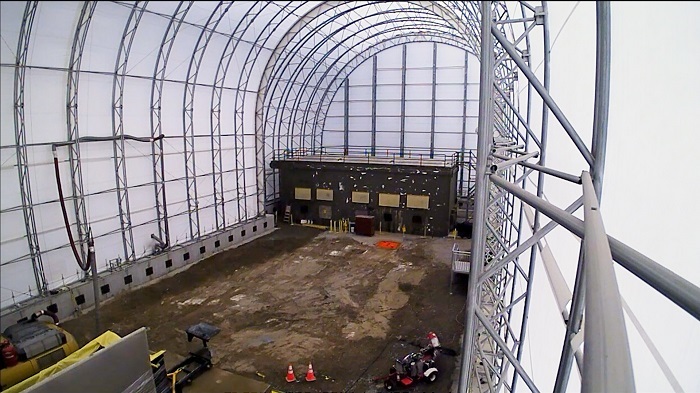 A view of the final remaining hot cell at the former Radioisotope Development Laboratory at Oak Ridge National Laboratory (ORNL). Oak Ridge crews are preparing to demolish the cell. This work is being conducted under a six-story protective structure erected last year to ensure nearby facilities and ongoing research missions at ORNL aren’t impacted by the cleanup.
 A crew moves a high-tech imaging camera into the final remaining hot cell at the former Radioisotope Development Laboratory at Oak Ridge National Laboratory. The detector overlays a radiation-intensity color-map on a picture of the environment to show nuclides and their locations.
Steps taken to enable characterization work include removing a wooden membrane covering the roof, installing and testing fire suppression and detection systems, placing gravel over the exposed floor to reduce dust inside the protective cover, and installing a negative air machine to provide localized ventilation during characterization and future deactivation.
"Preparing to demolish contaminated structures requires a lot of preparation to safely complete the demolition," Oak Ridge Reservation Environmental Cleanup Program Manager Dan Macias said. "The removal of this hot cell is another significant step forward in ongoing cleanup activities at ORNL.”
The cell set to be deactivated and demolished will join five other cells and an outer structure previously demolished. The outer structure and four of the cells were demolished in prior years, and the fifth cell was demolished earlier this year.
The cells were heavily shielded concrete rooms that provided researchers protection from radioactive material as they conducted research. The laboratory was built in 1945 to support isotope separation and packaging and was later used to examine irradiated reactor fuel experiments and components.
-Contributor: Carol Hendrycks
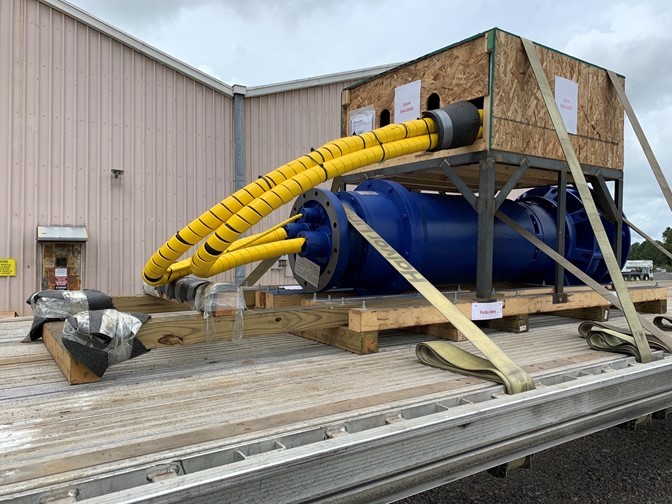 An enhanced commercial submersible mixer pump, designed by Savannah River Remediation for use in Tank 33 bulk waste removal efforts, arrives at the Savannah River Site.
AIKEN, S.C. – EM and it’s liquid waste contractor at the Savannah River Site (SRS) have developed a unique commercial mixer pump to use in a tank with space limitations, allowing waste retrieval efforts to advance in the tank farms.
Savannah River Remediation (SRR) currently uses commercial submersible mixer pumps (CSMPs) as the primary mixing device for waste retrieval in the majority of the tanks. The tank waste, composed of salt and sludge, needs to be mixed with water to allow the waste to be moved between tanks via transfer pumps and lines.
Typically, four CSMPs are used in each tank based on each pump’s nozzle discharge reach, known as the effective cleaning radius. The pumps are inserted into the tank through riser openings at the top of waste tanks. However, in Tank 33, cooling coils are deployed in the openings, limiting the space for the pumps to be inserted. Other tanks have internally built cooling coils that do not limit the number of access riser openings in a tank.
For this reason, SRR designed an enhanced version of the mixer pumps specifically for Tank 33. It will provide a 50-foot effective cleaning radius within the tank versus the 29-foot radius provided by the regular CSMPs. The longer effective cleaning radius decreases the number of pumps from four to three that are needed during the bulk waste removal process.
The enhanced CSMP is the first-of-its-kind pump developed for SRR, according to Mark Schmitz, SRR chief operating officer and deputy project manager.
“The successful implementation of the enhanced mixer pump is essential for the current strategy of bulk waste removal in Tank 33,” Schmitz said. “Once proven successful in Tank 33, SRR could deploy enhanced pumps in similar tanks.”
Tank 33 is one of six waste tanks currently undergoing waste removal efforts, which advances EM’s mission of waste tank closure, according to DOE-Savannah River Assistant Manager for Waste Disposition Jim Folk.
“Removing waste from aging waste tanks continues to be one of the Department’s top priorities because each tank emptied reduces the risk posed to the community and environment,” Folk said. “The development of innovative solutions to continue waste retrieval efforts when faced with infrastructure or operational challenges is key to our long-term success.”
The enhanced CSMP was developed by a small business named GPM, Inc.
-Contributor: Colleen Hart
RICHLAND, Wash. – Crews are upgrading security barriers at the three vehicle barricades on the Hanford Site, adding concrete barriers and relocating sand barrels placed in front of the guardhouse.
“Due to the national security assets that DOE is responsible for protecting, access is limited and securely maintained at all times by a professional, armed protective force,” said Timothy Haddick, security, emergency services, and information management division director. “Upgrades to security also benefit our safety posture, due to the unique hazards to people and the environment at the Hanford Site. Our ongoing investment in site access control is vital to continuing to effectively maintain security and safety.”
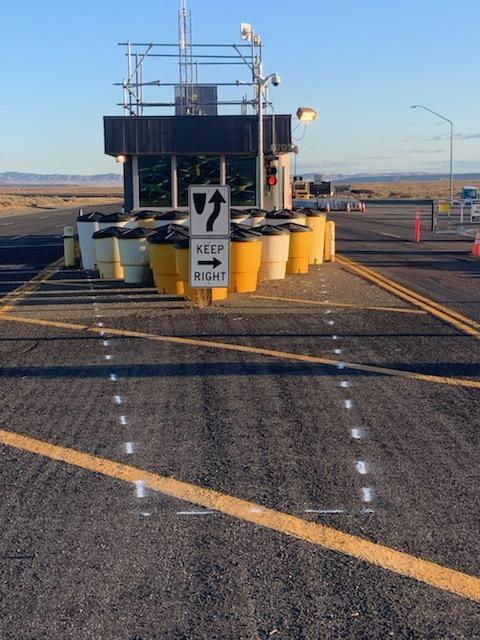 |
|
Before: The Hanford Site previously used an arrangement of sand barrels to provide an added layer of vehicle protection to the site’s access points. |
After: Improvements to a vehicle security barricade on the Hanford Site include a permanent concrete barrier used in conjunction with sand barrel barriers to protect the guardhouse and patrol staff. |
|
 |
Employees access the Hanford Site through one of three vehicle barricades by displaying appropriate credentials. EM Richland Operations Office (RL) contractor Hanford Mission Integration Solutions (HMIS) used feedback from the Hanford Patrol, roads and grounds staff, and engineers before starting the upgrades recently.
Near the guardhouse of the first barricade to receive upgrades, workers added a concrete barrier, which offers permanent protection, and reduced the number of sand barrels, which are susceptible to degradation from ultraviolet sun rays and periodically need to be replaced.
“The upgrades will protect the patrol officers, the guardhouse infrastructure, and reduce future costs needed to replace barrels,” said Brian Von Bargen, vice president of interface and integration services for HMIS.
A barricade closest to nearby Richland was the first to receive the upgrades. Two other barricades on the western side of the site will also receive similar upgrades.
-Contributor: Robin Wojtanik
|